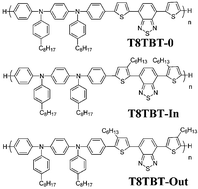Synthesis and characterization of low bandgap conjugated donor–acceptor polymers for polymer:PCBM solar cells†
Abstract
We report on the synthesis, characterization and photovoltaic performance of three novel semiconducting

* Corresponding authors
a
Melville Laboratory for Polymer Synthesis, Department of Chemistry, University of Cambridge, Lensfield Road, Cambridge, UK
E-mail:
wtsh2@cam.ac.uk
Fax: +44 1223 334866
Tel: +44 1223 334370
b Cavendish Laboratory, Department of Physics, University of Cambridge, J J Thomson Ave., Cambridge, UK
We report on the synthesis, characterization and photovoltaic performance of three novel semiconducting

 Please wait while we load your content...
Something went wrong. Try again?
Please wait while we load your content...
Something went wrong. Try again?
G. Tu, S. Massip, P. M. Oberhumer, X. He, R. H. Friend, N. C. Greenham and W. T. S. Huck, J. Mater. Chem., 2010, 20, 9231 DOI: 10.1039/C0JM01641A
To request permission to reproduce material from this article, please go to the Copyright Clearance Center request page.
If you are an author contributing to an RSC publication, you do not need to request permission provided correct acknowledgement is given.
If you are the author of this article, you do not need to request permission to reproduce figures and diagrams provided correct acknowledgement is given. If you want to reproduce the whole article in a third-party publication (excluding your thesis/dissertation for which permission is not required) please go to the Copyright Clearance Center request page.
Read more about how to correctly acknowledge RSC content.
 Fetching data from CrossRef.
Fetching data from CrossRef.
This may take some time to load.
Loading related content
